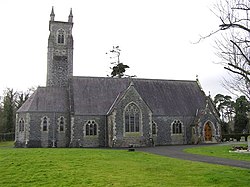Killadeas
| Killadeas | |
| Fermanagh | |
|---|---|
 "The Priory" Church of Ireland | |
| Location | |
| Grid reference: | H206540 |
| Location: | 54°26’3"N, 7°40’57"W |
| Data | |
| Population: | 90 (2001) |
| Dialling code: | 028 |
| Local Government | |
| Council: | Fermanagh and Omagh |
| Parliamentary constituency: |
Fermanagh and South Tyrone |
Killadeas is a small village in Fermanagh. It is about seven miles north of Enniskillen and standing near the shores of Lower Lough Erne. At the 2001 Census it had a population of 90 people.
The name of the village is from Cill Chéile Dé, meaning 'Church of the Culdees'.
The Royal National Lifeboat Institution operates a lifeboat station on Lower Lough Erne at Killadeas. It works in conjunction with another lifeboat station on Upper Lough Erne at Carrybridge.[1]
History
In the cemetery of the Church of Ireland Parish "Priory" Church of Killadeas are several stones, the most noted of which is known as the Bishops Stone. On one side an ecclesiastic is portrayed with bell and crozier and on the other is a head in relief and a panel of interlace carving. The head was carved before the ecclesiastic was added to the other surface and the stone trimmed at yet another period because both head and ecclesiastic were damaged as a result.[2] The figure carved stone and cross-slab are Scheduled Historic Monuments and are in Rockfield townland (H206540).[3][4]
To the west of this stone is a large slab, one side of which has at least ten cup-shaped hollows, which is possibly a multiple bullaun stone. Near to this is a hole stone and a pillar.
Near Killadeas, on Lower Lough Erne, is Gublusk Bay, a Royal Air Force base for Short Sunderland and PBY Catalina flying boats during Second World War. Building at RAF Killadeas started in January 1941 and the first Catalinas arrived two months later. The site is now the home of the Lough Erne Yacht Club.
The Manor House (Hotel), a converted and extended 19th-century country manor, is also in Killadeas. The Killadeas Estate was acquired by Captain J. Irvine in 1660, and the Manor House, formerly known as "Rockfield" (rebuilt 1860) remained part of the Irvine Estate until 1957, when it was purchased for use as a hotel. The Manor House, which has seen many alterations to its design over the centuries, was for a brief period used as an Officer's Mess and Headquarters for the American Forces during Second World War.
Outside links
- Killadeas Pipe Band
- County Fermanagh Airfields: Second World War in Northern Ireland
- Airfields of Britain Conservation Trust: Killadeas
- Killadeas Church and Churchyard
References
- ↑ McAloon, Nuala. "RNLI's first permanent inland lifeboat station now complete at Carrybridge". http://rnli.org/NewsCentre/Pages/RNLIs-first-permanent-inland-lifeboat-station-now-complete-at-Carrybridge.aspx. Retrieved 19 April 2015.
- ↑ O'Kelly, MJ (1989). Early Ireland. Cambridge: Cambridge University Press. p. 293.
- ↑ Dept of the Environment NI (1987). Historic Monuments of Northern Ireland. Belfast: HMSO. pp. 152–3.
- ↑ Hamlin, Ann; Hughes, Kathleen (1997). The Modern Traveller to the Early Irish Church. Dublin: Four Courts Press. p. 123.